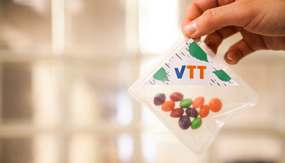
VTT has developed a pulp-based packaging material for use with sweets, for example. © Ville Jäppinen
800,000 Eiffel Towers. That is how much the plastic produced in the world between 1950 and 2015 weighs. Of this amount, a third is still in use, just under a tenth has been utilised in energy production and approximately six per cent has been recycled. Over half of all the plastic produced in the world lies in landfills and in the environment.
According to VTT, halving the environmental impact of plastic in the next ten years is possible by improving plastic recycling, replacing plastics with renewable materials and changing consumption habits.
Recycling at the heart of the change
A significant share of plastic waste consists of packaging. Many products are packed in several layers of different types of packaging plastic, the identification of which is difficult for consumers. As such, one of the central means of improving recycling would be to clarify the terminology used about plastic.
“To promote sorting, we must change the way we talk about plastics. After all, it’s not like we lump different metals together either,” says Special Researcher Maija Pohjakallio from VTT.
In an ideal situation, each type of plastic would be recycled in a dedicated, closed system. This system could be modelled after a deposit-based bottle recycling system, for example.
“In Finland, approximately 90% of soft drink bottles are recycled, so incentivising consumers to sort could increase the recycling rate of other plastics as well,” says Research Professor Ali Harlin from VTT.
Updating plastic recycling methods could enable the collection of more homogenised plastic with better recycling potential than mixed plastic. Currently the majority of recycled plastic is mixed plastic, as a result of which recycled plastic is mainly used to make plastic flower pots and not much else.
“While flower pots are a good recycled product, we don’t need millions of them,” Harlin summarises.
Boosting recycling with new technologies
Unfortunately the fact is that it is simply not cost-effective to develop a dedicated, closed recycling system for every type of plastic. Instead, researchers have developed new chemical and mechanical methods for increasing the recycling rate of mixed plastic.
According to Pohjakallio, collection must be supported with effective recycling methods.
“It is not enough to simply collect plastic, we must also put it back to use,” Pohjakallio summarises.
Chemical methods make it possible to separate different types of plastics from one another and turn them back into their original, pure raw materials. The recycled plastic produced in this way would be much more durable and versatile than conventional recycled plastic.
“Efficient recycling systems would make it possible to produce approximately a third of the world’s plastics in a renewable manner that is still economically viable,” Pohjakallio adds.
Although pilot machines for improving the mechanical and chemical recycling of plastic have already been developed in Tampere, the plastic problem cannot be solved with technology alone. The rest is up to structural changes that must be carried out throughout our systems and in our way of thinking.
The solution lies in changing the way we think
According to VTT, the plastic problem is a systemic problem, the solving of which requires changing the prevailing system. Consumers’ attitudes, the plastic industry’s operating methods and political decision-making must all become more sustainable.
Product development also offers means of addressing the plastic problem. We should shift from a ‘material first’ approach to a ‘need first’ approach, which would also pave the way for new kinds of innovations, such as the adoption of pulp-based alternatives to plastics.
However, in the end change is up to the consumer.
“Every one of us can contribute to the solving of the plastic problem by evaluating their own consumption. Instead of food packaged in plastic, you should favour locally produced fresh food and products that are as free of plastic as possible,” Harlin summarises.
More information
- Research Professor Ali Harlin, firstname.lastname@vtt.fi
- Special Researcher Maija Pohjakallio, firstname.lastname@vtt.fi